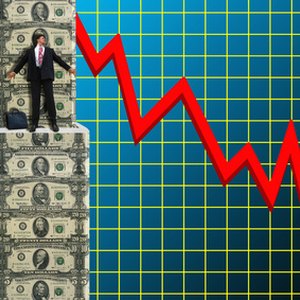
Calculating investment returns on stock or a portfolio of stocks is usually done in one of two ways. An ex post analysis looks at past returns. It is a reliable indicator because all of the inputs to the calculations are already known. These calculations look at what you invested at the start, what you earned in income during a given time period, and what your investment could sell for at the end of the period. This analysis is done periodically to check how an investment has performed. The second type of approach is an ex ante analysis, which forecasts what an investment might return in the future.
Calculate single period returns using this formula: Ending price minus beginning price plus income divided by beginning price multiplied by 100. This will equal actual single period percentage return. For example, take a beginning price of $455, an ending price of $900 and a dividend of $25. This would calculate to a single-period return of 103.3 percent. This was calculated with 900 minus 455 plus 25 divided by 455. This equals 1.032967. Multiplied by 100, it equals 103.3 percent
Compound the single period returns to generate a cumulative return for the holding period using this formula,which is illustrated in the example. The year one return is 130.3 percent, the year two return is 12.5 percent, the year three return is 45.3 percent, the year four return is -44.1 percent and the year five return is 1.2 percent. This generates a cumulative five-year return of 170.0 percent that was calculated using the formula: (1.00 plus 1.1303) multiplied by (1.00 plus .125) multiplied by (1.00 plus .453) multiplied by (1.00 plus (-.441)) multiplied by (1.00 plus .012) equals 1.969932 multiplied by 100 equals 197.0 percent
Calculate the annualized cumulative ex post return by using the formula: Cumulative return taken to the exponent of the number of periods equals annualized ex post return, where the exponent of the number of periods indicates exponentiation; raising the value to the power of the number of periods. For example, where the cumulative five-year return is 1.969932 and the period is five years, the annualized five-year return (the average return of the stock over the five-year period) is 29.7 percent. The figure 1.969932 to the exponent of 5 equals 29.6658 or 29.7 percent.
Tips
To take negative period returns into account in the formula, subtract the negative return from 1. For example, 1 (- .441) or .559.
Use any time period you wish to measure, but you should annualize only when the entire holding period is greater than a year.
References
Tips
- To take negative period returns into account in the formula, subtract the negative return from 1. For example, 1 (- .441) or .559.
- Use any time period you wish to measure, but you should annualize only when the entire holding period is greater than a year.
Writer Bio
With more than 30 years of writing and consulting experience in the investment and retirement planning industries, Jeanette Schreiber provides easy-to-understand articles on organizing your finances, evaluating investment options and working toward long-term financial security. With an English bachelor's degree from Northwestern University, she writes informational articles as well as short stories, poetry and creative nonfiction.

